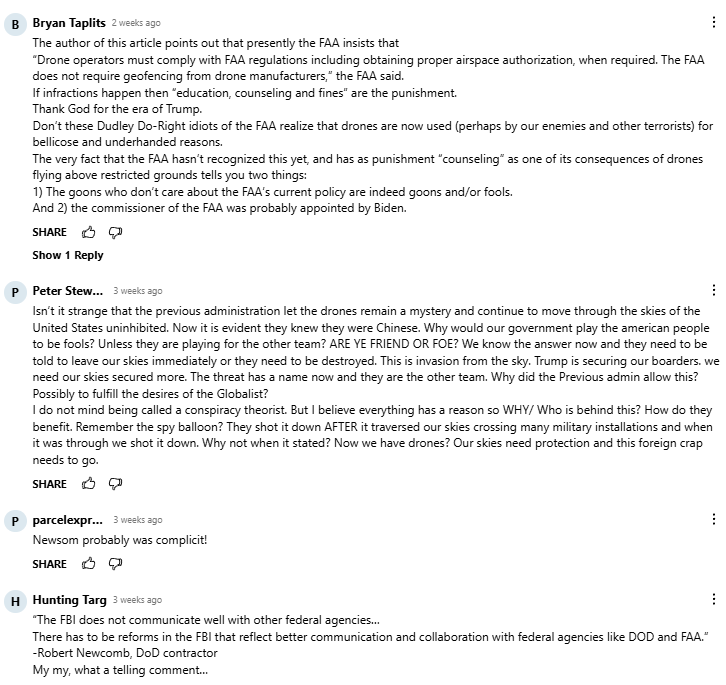DEFEND UTAH
Articles & Interviews
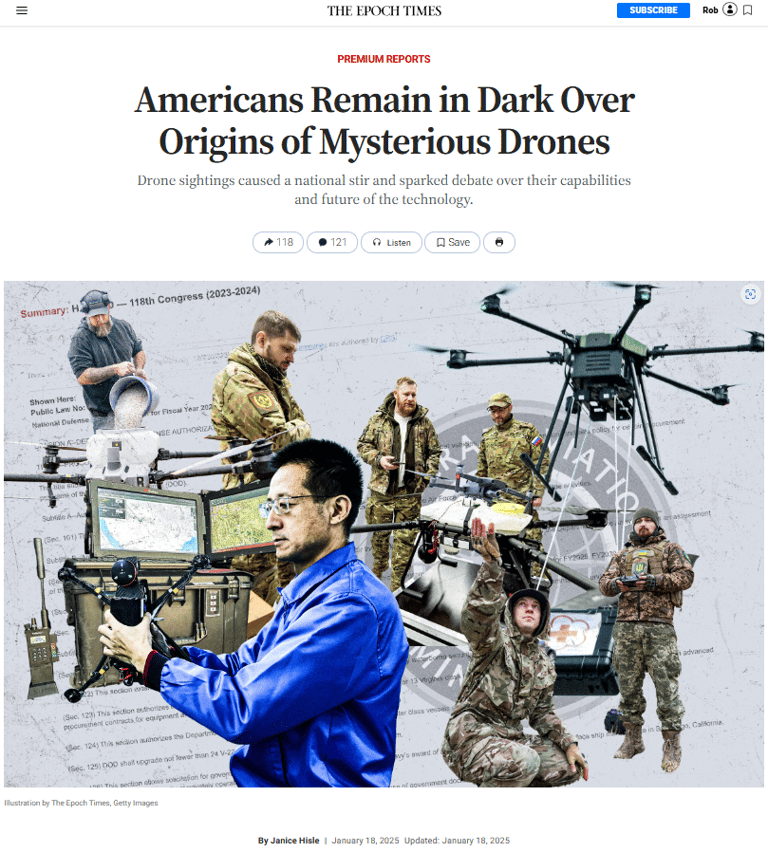

Many people wondered aloud whether foreign adversaries deployed the suspected drone swarms as a spy operation. Thompson refuted that notion.
“These are not enemy drones,” Thompson said. “There’s no way it was an enemy. They wouldn’t put on FAA lighting ... that’s just ridiculous—or they’re the dumbest enemy.”
Drones used for reconnaissance or other military missions fly without lights, he said; these drones are even undetectable by a person wearing night-vision goggles.
“Our drones are stealth, and you want them stealth,” Thompson said.
Robert Newcomb, a weapons engineer and DOD contractor who works with drones. Courtesy of Robert Newcomb
Based on Newcomb’s career knowledge, the reported objects seem to be “nothing out of the ordinary,” he said.
Newcomb said the sightings didn’t set off alarm bells for him.
“Usually, if it’s going to be a threat, they’re going to act quickly,” he said. The drones caused no apparent harm as they hovered or flitted about the sky for prolonged periods.
Further, Newcomb said, U.S. agencies have capabilities for detecting and engaging threats in airspace.
“Should we be fearful? The answer is a hard ‘no,’” he said. “But there’s a caveat to that.”
'Not Enemy Drones'
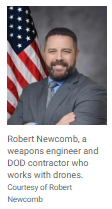

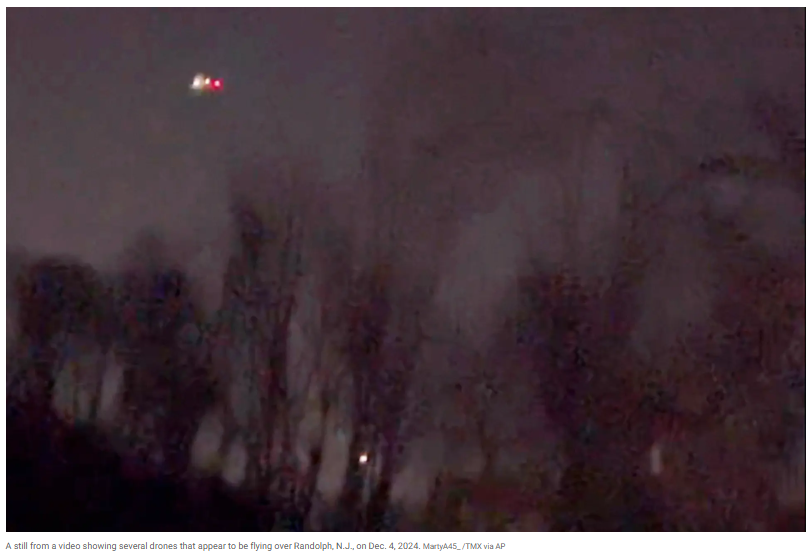

Still, drone regulations need to be streamlined to ensure progress, the experts agree.
“Our nation’s defense is going to depend on drones going forward,” Thompson said.
Newcomb fears that over-regulation will “stifle innovation ... and how the technology advances.”
He suggests that “instead of forcing every drone to be tracked, we just offer an airspace for them to operate in.”
Evans commended the FAA for its emphasis on safety, which enables Americans to travel more safely in an airplane than in a car, federal data and numerous studies show.
Likewise, Evans believes the FAA is “doing a really good job of balancing the need for innovation” against security concerns.
Experts Offer Suggestions
“They’re doing a lot of exceptions. They’re doing a lot of test programs. They’re enabling a lot of the exploratory stuff,” he said.
At the same time, the FAA is concerned about avoiding “an overzealous cowboy environment that could lead to really dangerous things, with stuff falling out of the sky,” Evans said.
All four drone experts who spoke to The Epoch Times were unanimous in their recommendations that federal agencies communicate better with each other.
Garcia noted that the FAA “has no authority to take down a drone,” and therefore must rely on help from other federal agencies.
Newcomb said that officials need to answer questions from citizens more directly, rather than deflecting, and they can acknowledge that security concerns prevent them from disclosing certain details.
Garcia and Newcomb emphasized a need for the government to invest more heavily in counter-drone technology.
However, the experts concurred that federal agencies seem to be confronting drone-related concerns more effectively.
“I think we’re on the path to solving it,“ Newcomb said, ”to ensure that our airspace is safe.”
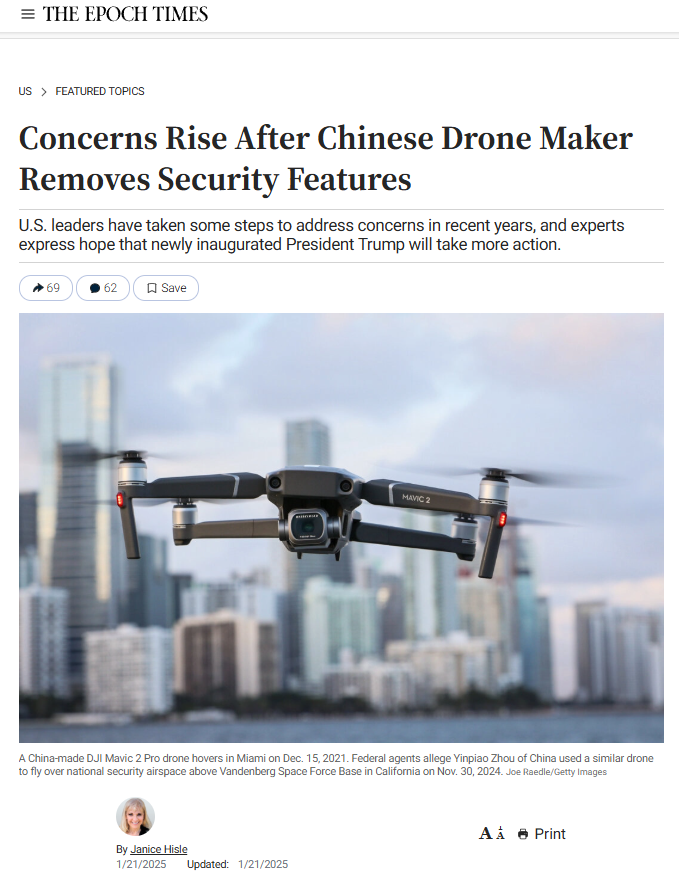

Concerns about U.S. security are intensifying, experts say, in the wake of changes recently enacted by the world’s predominant drone company—based in China.
“The fact that these drones will now be allowed to be flown freely—without any sort of built-in restrictions—in the national airspace is absolutely a cause of concern,” Gabriel Garcia, technical director for SPS Aerial Remote Sensing, a Texas company specializing in counter-drone technology, told The Epoch Times.
For more than a decade, Da-Jiang Innovations, better known as DJI, had employed “geofencing” that automatically blocked operators from entering restricted airspace or “no-fly zones,” as declared by the Federal Aviation Administration (FAA). Those zones, which include high-profile locations such as the White House, can also temporarily encompass scenes of natural disasters or large public gatherings.
But DJI, which holds a 90-percent share of the global drone market, eliminated the geofencing feature from most of its drones being used in the United States. The company took that action on Jan. 13, a week before President Donald Trump’s inauguration and shortly after mysterious drone sightings in several states.
DJI’s announcement triggered concerns from citizens and experts alike, not only because of the timing but also because of allegations that the company may have been funneling “U.S. critical infrastructure and law enforcement data to the Chinese government,” a 2017 U.S. Intelligence Bulletin said. Since then, Congress has taken several steps to counter the perceived threat, including prohibiting the Department of Defense (DOD) from using Chinese-made drones or drone parts.
The company has denied the allegations. DJI says that “critics have propagated a multi-year political campaign alleging security issues with DJI drones,” but independent audits and user testimonials left those claims unsupported.
DJI said it was removing the geofencing to align with “similar changes implemented in the European Union (EU) last year.”
As a result of the change, a DJI online app will notify users if they fly drones near FAA-designated “controlled airspace.” The company also said the decision puts control back into operators’ hands and underscores the principle that they bear “final responsibility” for drone use.
FAA Addresses Issues
When asked to comment on DJI’s decision and any concerns stemming from it, the FAA responded to The Epoch Times in more general terms, saying that the agency aims “to ensure drones operate safely within the National Airspace System.”
Further, “Drone operators must comply with FAA regulations including obtaining proper airspace authorization, when required. The FAA does not require geofencing from drone manufacturers,” the FAA said.
In addition, the FAA noted that it is generally legal to fly a drone “in most locations if you’re operating under 400 feet.” However, drone users must comply with rules, the agency said, “including passing pilot safety tests, keeping the drone in sight, avoiding all other aircraft, not causing a hazard to any people or property, and avoiding restricted airspace.”
The FAA Safety Team works to educate drone users, and “when violations occur, the FAA can take actions ranging from counseling and education to stiff fines and pilot certificate suspensions or revocations.”
DJI’s online announcement was detailed but did not address reasons for the timing of its geofencing removal. The company, which did not reply to The Epoch Times’ request for comment, is headquartered in Shenzhen. Founded in 2006, the company now has operations in the United States, Germany, the Netherlands, Japan, South Korea, Beijing, Shanghai, and Hong Kong.
Garcia noted that DJI had voluntarily imposed the geofencing requirements—unlike many other drone manufacturers; some do not require internet connectivity, which is what DJI used to impose the geofencing and will now use for the user “alerts” about nearing restricted airspace.
He also conceded that “anyone with YouTube access or a few dollars and a Google browser can figure out how to bypass those restrictions.”
Still, Garcia said that DJI’s removal of the geofencing was troubling. Returning control to operators might sound like a good idea, but many of them remain ill-informed about the ramifications of flying into restricted airspace, he said.
The company says it has been an industry leader in drone safety. DJI said it was the first drone company to implement Remote ID, geofencing, and other safety-focused features, including altitude limits, “return-to-home” technology for drones that lose connections or are low on battery power, and sensors to detect obstacles and approaching aircraft.
Action From FBI, Other Agencies?
But Robert Newcomb, a Utah-based weapons engineer and DOD contractor who works with drones, said America’s lack of counter-drone technology and coordination among U.S. agencies “opens up a real concern” over DJI’s geofencing removal.
“The FBI does not communicate well with other federal agencies like the FAA,” he told The Epoch Times. “The FBI should be having classified briefings with the FAA to help them understand the threat and make informed decisions about domestic regulation.”
The Epoch Times contacted the FBI for comment during the final days of President Joe Biden’s administration but received no reply.
Now that Trump is in office, Newcomb says he hopes that Trump’s pick for FBI director, Kash Patel, will enact the needed changes to improve U.S. counter-drone technology and tactics.
“There has to be reforms in the FBI that reflect better communication and collaboration with federal agencies like DOD and FAA,” he said.
Newcomb, a civilian, says he is “well-versed in applying technology to known classified threats in a theater of war.” But he said the FBI has previously rebuffed his efforts to alert the agency to suspected threats.
“They wouldn’t even interview me or make a report,” Newcomb said, despite several FBI visits during the past several years.
Hours after his inauguration, Trump addressed the recent spate of drone sightings. “I would like to find out what it is and tell the people,” he told reporters on Jan. 20 as he signed a flurry of executive actions. The newly inaugurated president also asked Susie Wiles, his chief of staff: “Why don’t we find out immediately?”
Trump also said he doubted that enemies of the United States were operating the drones; if that had been the case, he thinks American forces would have intercepted the aircraft and destroyed them. He suggested that U.S. officials “may have been testing something.” But if that were the case, “I don’t know why they wouldn’t have said what it was.”
